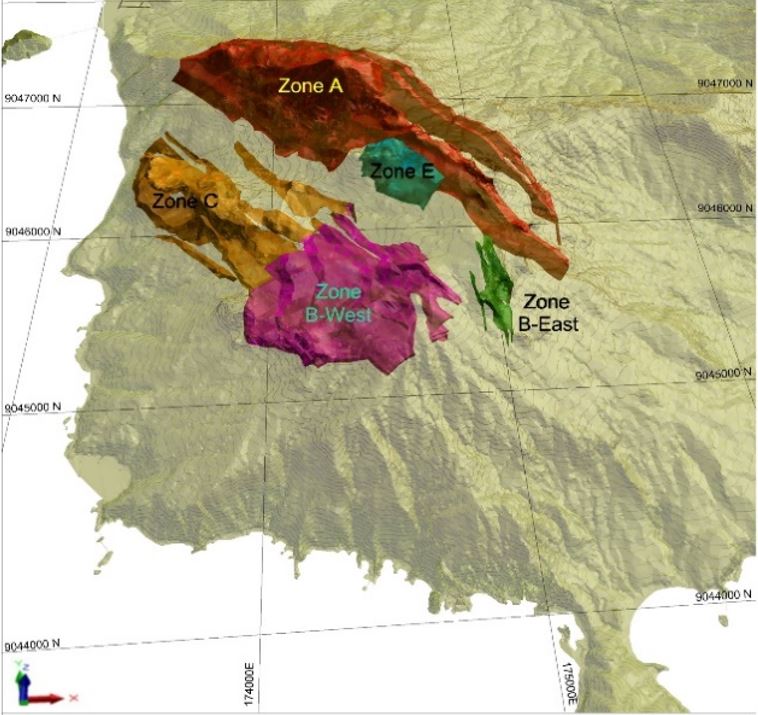Fluid Inclusion Study of The Tumpangpitu High Sulfidation Epithermal Gold Deposit in Banyuwangi District, East Java, Indonesia
DOI:
https://doi.org/10.24273/jgeet.2018.3.01.1039Keywords:
Fluid inclusion, High Sulfidation Epithermal Gold Deposit, Tumpangpitu, East Java, IndonesiaAbstract
The Tumpangpitu high sulfidation (HS) epithermal gold deposit is located in the south coast of East Java, Banyuwangi District, East Java Province, Indonesia. This area lies within the central portion of the Cenozoic Sunda‐Banda magmatic arc which trends southeast from northern Sumatra to west Java then eastward through east Java, Bali, Lombok, Sumbawa and terminating at Banda sea. The geology of the Tumpangpitu is predominantly occupied by Late Oligocene to Middle Miocene low-K calc-alkaline to alkaline andesitic volcanic rocks and interbedded with volcaniclastic rock sequences, which are associated with low-K intermediate intrusions. The mineralization style at the Tumpangpitu area is composed of a high‐sulfidation (HS) epithermal gold-copper system which is typically associated with concealed gold-rich porphyry copper system. The HS epithermal mineralization is hosted by volcanic and volcaniclastic rocks in this research area. The mineralization domains are divided into Zone A, Zone B and Zone C which are situated along NW-SE-trending silica ledges zones. The HS epithermal mineralization is texturally occurs as vuggy replacements mineralization as well as stockworks, disseminated forms, fractures and veins. Fluid inclusion study was conducted for 6 quartz vein samples which petrographically entrapped fluid inclusions. Homogenization temperature (Th) and melting temperature (Tm) can microthermometrically be determined by fluid inclusion analysis. The average homogenization temperature (Th) of the fluid inclusions gives 180˚C to 342˚C and melting temperature are from -0.1 ˚C to -1.4˚C. Tm corresponds to the salinities ranging from 0.1 to 4.5 wt% NaCl equivalent. The paleodepth of ore formation can be estimated from the salinity of fluid. Since the deposit was not formed at boiling condition, the minimum paleodepth of ore (quartz) samples taken from both shallow level (53.35 m) and deep level (135.15 m) is determined at 650m and 1,220 m, respectively. The microthermometric data point out that the Tumpangpitu deposit formed at moderate temperature and low salinity by magmatic fluid mixing and dilution by meteoric water during the hydrothermal fluid evolution. On the basis of the fluid inclusion microthermometric data and its other key characteristics, the Tumpangpitu gold mineralization shares some similarities compared to other typical HS-epithermal gold deposits worlwide although it also shares few differences.
Downloads
References
Bodnar, R.J., Reynolds, T.J., and Kuehn, C.A., 1985. Fluid inclusion systematics in epithermal systems, Reviews in Economic Geology 2, 73–79.
Bodnar, R. J. and Vityk M.O., 1994. Interpretation of microthermometric data for H2O-NaCl fluid inclusions.
Carlile, J.C. and Mitchell, A.H.G., 1994. Magmatic arcs and associated gold copper mineralization in Indonesia, Journal Geochemical Exploration, 50, 91–142.
Hass, J.L., 1971. The Effect of Salinity on the Maximum Thermal Gradient of a Hydrothermal System at Hydrostatic Pressure, Economic Geology 66, 940–946.
Harrison. R., 2012. Indonesia Basin Summaries, North East Java Sea Basin and North East Java Basin, p. 69-94, 2006.
Hellman, P. L., 2011. Intrepid Mines Limited, Tujuh Bukit Project, Report on Mineral Resources, Located in East Java, Indonesia, Technical Report for Intrepid Mines Limited.
Macpherson, C.G. & Hall, R., 1999. Tectonic controls of geochemical evolution in arc magmatism of SE Asia. Proceedings PACRIM, 99, 359-367.
Maryono, Setidjaji, L.D., Arif .J., Harrison, R., Soeriaatmadja, E., 2014, Gold, Silver, and Copper Metallogeny of the Eastern Sunda Magmatic Arc Indonesia, Majalah Geologi Indonesia, Vol.29 No.2 August 2014: 85-99.
Roedder, E., 1984. Fluid inclusions, Mineralogical Society of America, Review in Mineralogy 12, 646.
Shepherd, T.J., 1985. A Practical Guide to Fluid Inclusion Studies, Balckie, p. 237.
Wilkinson, J.J., 2001. Fluid inclusions in hydrothermal ore deposits, Lithos 55, 229–272.

Downloads
Published
Issue
Section
License
Copyright @2019. This is an open-access article distributed under the terms of the Creative Commons Attribution-ShareAlike 4.0 International License which permits unrestricted use, distribution, and reproduction in any medium. Copyrights of all materials published in JGEET are freely available without charge to users or / institution. Users are allowed to read, download, copy, distribute, search, or link to full-text articles in this journal without asking by giving appropriate credit, provide a link to the license, and indicate if changes were made. All of the remix, transform, or build upon the material must distribute the contributions under the same license as the original.










